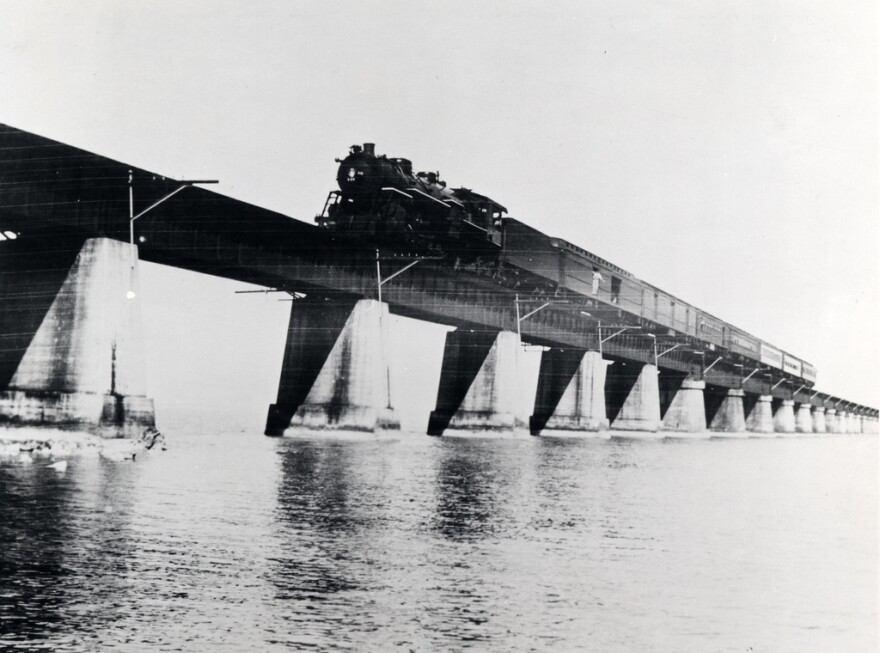There was a time when the only way to get to Key West was by boat. Then came the oil and rail magnate Henry Flagler.
WLRN is here for you, even when life is unpredictable. Our journalists are continuing to work hard to keep you informed across South Florida. Please support this vital work. Become a WLRN member today. Thank you.
His railroad opened the east coast of Florida to the rest of the country. He helped develop West Palm Beach and Miami. But his most ambitious dream was to extend his railroad all the way to Key West, over difficult terrain and open water.
Author Les Standiford wrote the book about Flagler’s dream. It's called ‘Last Train to Paradise: Henry Flagler and the Spectacular Rise and Fall of the Railroad that Crossed an Ocean.’
WLRN’s Luis Hernandez spoke with Standiford about his book, which is the Sundial Book Club selection for the month of January. You can join the club here.
This conversation has been edited for length and clarity.
WLRN: Was Florida, especially South Florida, destined for growth and population expansion, even if Henry Flagler had not built that railroad? Do you think it would have happened anyway?

STANDIFORD: Well, of course, obviously we would have grown and grown mightily because what's not to like down here? The same things that draw people, the beauty of the climate and now the very diversity of cultures and food. This is like the American Casablanca that would have all occurred sooner or later.
But Flagler was the man who did it, and he did it when he did it. Who knows how long it would have been before South Florida was discovered? He's the guy who brought the railroad here and with its civilization for that matter, he made all east coast of Florida possible. You could have drawn a line from St. Augustine across to Tampa, and everything south of that line would have had a big stamp like the map makers used to put “terra incognita,” because there wasn't anything there until you got to Key West. Key West had always been a thriving, basically, Caribbean port. But it was detached from Florida. Had no real connection to Florida.
One of the things I loved about the book is you had quite a few different people’s descriptions of Henry Flagler from his time, people from his era writing about him. How would you describe him?
He was a workaholic. This comes from, probably as a result of his penniless childhood and ingrained desire to succeed and that never goes away with a lot of people. I don't think it ever did with him. I mean, I think that's to explain why at age 75, he would undertake the building of the railroad from Miami to Key West across 155 miles of, largely, water. And there was no other practical explanation for it, except that he was also stubborn and prideful. I think that when people got wind of the rumor that he was going to do this and scoffed at it, “Flagler’s folly,” they call it. Part of his motivation was to prove that by george, he could do it and he would do it.
[He] was a very proud guy. He had come to calling Florida “my domain” because in his eyes, he'd made the whole thing possible, at least, as I say, the eastern half of the state possible by bringing the railroad there and allowing people to establish farms where they can grow crops and send the fruits back on the railroad. [Also] to allow people to travel and enjoy the beauty of the beaches. This is a guy who spent the first 52 years of his life as an extractor of oil. He was the partner of John D. Rockefeller and Standard Oil and he went really from an exploiter to a developer, to a creator with these hotels and making cities possible. And that gave him immense pride.
Then Julia Tuttle tried to convince him to bring the railroad down to Miami. And at first, he wasn't really sold on that idea. Miami was nothing at the time. We think of Julia Tuttle as the founder of the City of Miami. But I have to ask you, who do you think played a bigger role in the creation of Miami? Was it Julia Tuttle or was it Henry Flagler?
There's a story that Julia after a big, hard freeze swept way south in Florida, where they had near killed all the citrus crops except in Miami, [she] sent a bowl of unfrosted orange blossoms up to Flagler in Palm Beach and said, ‘look, if there was ever a frost-proof, place this is it. Bring your railroad to Miami. Mr. Flagler.’ And that may be an apocryphal story.
I'm sure that word reached Flagler that the freeze had not killed the crops in Miami and Julia Tuttle might have been the one that made that happen. Whether or not there was an armload of blossoms ever delivered, nobody really can say for sure. What really sealed the deal was that she convinced another settler in Miami to give half. She said, ‘look, I'll donate half of my homestead, 320 of my 640 acres. You donate 320 from yours. We'll give it to Flagler in return for bringing the railroad to Miami. And I think that's really what truly made it happen.




